What is the Latarjet Procedure?
The shoulder joint provides a wide range of movement to the upper extremity, but overuse or trauma can cause instability to the joint. The Latarjet procedure is a surgical procedure performed to treat shoulder instability by relocating a piece of bone (coracoid process) with an attached tendon to the shoulder joint.
Disease Overview
The shoulder joint is a ball and socket joint with the head of the humerus (long arm bone) forming the ball, and a cup shaped depression on the shoulder blade (glenoid fossa) forming the socket.
The joint is stabilised by the labrum, a cartilaginous rim of the glenoid cavity, and the capsule, a series of ligaments that enclose the joint. Injury and trauma can tear or stretch the labrum and/or ligaments, causing instability and dislocation of the joint. The shoulder can dislocate in front (anterior), down (inferior) or behind (posterior), but anterior dislocation is the most common. Tearing of the labrum due to trauma is called a Bankart tear, which sometimes involves the breaking of bone along with the labrum. This is referred to as a bony Bankart tear. Shoulder instability can lead to pain and a feeling of giving way.
What are the Indications for the Latarjet Procedure?
The Latarjet procedure is indicated for anterior shoulder instability that is recurrent and caused by a bony Bankart lesion.
The surgery is also considered as a revision option after surgical repair of the labrum (Bankart repair) has failed and the patient has further shoulder instability.
Importantly though, it is considered in higher risk individuals where a standard Bankart repair has a higher rate of failure because it may not be enough to stabilise the shoulder. Therefore, the Latarjet procedure should be considered instead of Bankart repair, in younger active patients, particularly involved in collision sports such as AFL and Rugby.
What are the Benefits of the Latarjet Procedure?
The Latarjet procedure is a very reliable and robust technique to restore stability to the shoulder joint by using a nearby bone block (coracoid process).
The benefits of the Latarjet procedure is 2-fold and can be described as both the bony and soft tissue effect. The bony effect is that it increases the amount of bone at the front of the shoulder socket (glenoid) by 30-50%. The ball (humerus) therefore has to move so much further along the socket before it even comes close to dislocating. The soft tissue effect is that it allows the tendons still attached to the bone block, to act like a sling and actually push back on the shoulder when the shoulder is in the vulnerable overhead position, the so called ‘sling-effect’.
Accelerated rehabilitation is also possible after the Latarjet procedure as bone to bone healing of the bone block to the socket is quicker and more reliable than soft tissue healing of a Bankart repair. Return to sports including contact/collision sports such as AFL and Rugby is therefore possible within 3 months and allows for in-season surgery rather than waiting after the season.
The Latarjet Procedure
The Latarjet procedure is performed under general anaesthesia with the patient in a semi-reclined or beach-chair position.
- An incision of 5 cm is made over the front of your shoulder.
- Retractors are used to separate the muscles of the shoulder and chest to expose the coracoid process (a small hook-like process of the shoulder bone) and its attached tendons.
- The coracoid process is freed of its attachments except for the conjoined tendon, and is transected from its base.
- Holes are drilled into the transacted coracoid process.
- The subscapularis muscle, which passes in front of the shoulder joint is split in line with its fibres.
- The capsule of the shoulder joint is entered and the front of the glenoid is exposed and prepared to receive the coracoid.
- The transected coracoid with the conjoined tendon is passed through the separated subscapularis muscle and fixed to the glenoid rim with 2 solid screws through the previously drilled holes. This increases the glenoid surface and stabilises the joint. The conjoined tendon passing through the subscapularis muscle provide additional stability by acting as a sling when the arm is in the overhead position.
- Upon completion, the instruments are withdrawn, the incision is closed and covered with a sterile bandage.
Postoperative Care for the Latarjet Procedure
Following the procedure your arm is placed in a sling to rest the shoulder and promote healing. You may remain in the hospital the night of the surgery before being discharged to home the next morning. Pain is controlled with medication and ice packs. You will be instructed to keep the surgical wound dry. The sling is only for comfort and may be removed within 1-2 weeks.
Rehabilitation usually begins early on the first postoperative day with full range of motion exercises allowed as tolerated from Day 1. A physiotherapy program is recommended for 3 months after which you can return to your regular activities including contact sports once the coracoid bone graft has healed.
Risks and Complications of the Latarjet Procedure
The Latarjet procedure usually provides good results but as with all surgical procedures, complication can occur and include:
- Haematoma (bleeding)
- Fracture or failure of union of the coracoid.
- Stiffness due to inadequate rehabilitation
- Recurrence of instability and infection are uncommon

